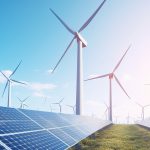Thinking about climate change can be overwhelming. We’ve been aware of its causes for decades now, and all around us, we bear witness to its devastating effects on our communities and ecosystems.
But the good news is that we now know exactly what it will take to win the fight against climate change, and we’re making measurable, meaningful progress. Game-changing developments in clean energy, electric vehicle technology, and energy efficiency are emerging every single day. And countries—including Canada, China, India, and the United States—are coordinating and cooperating at levels never seen before in order to tackle the most pressing issue of our time.
The bottom line: If the causes and effects of our climate crisis are clearer than ever, so are the solutions.
Ending our reliance on fossil fuels
The single-most important thing that we can do to combat climate change is to drastically reduce our consumption of fossil fuels. The burning of coal, oil, and natural gas in our buildings, industrial processes, and transportation is responsible for the vast majority of emissions that are warming the planet—more than 75 percent, according to the United Nations. In addition to altering the climate, dirty energy also comes with unacceptable ecological and human health impacts.
We must replace coal, oil, and gas with renewable and efficient energy sources. Thankfully, with each passing year, clean energy is making gains as technology improves and production costs go down. But according to the Intergovernmental Panel on Climate Change’s Special Report on Global Warming of 1.5°C, in order to meet the goal of reducing global carbon emissions by at least 45 percent below 2010 levels before 2030—which scientists tell us we must do if we’re to avoid the worst, deadliest impacts of climate change—we must act faster.
There are promising signs. Wind and solar continue to account for ever-larger shares of electricity generation. In 2021, wind and solar generated a record 10 percent of electricity worldwide. And modeling by NRDC has found that wind, solar, hydro, and nuclear could account for as much as 80 percent of U.S. electricity by the end of this decade. (We can also fully realize our clean energy potential if we invest in repairing our aging grid infrastructure and installing new transmission lines.) While this transformation is taking place, automakers—as well as governments—are preparing for a future when the majority of vehicles on the road will produce zero emissions.
Greater energy efficiency
Energy efficiency has been referred to as “the first fuel”; after all, the more energy efficient our systems are, the less actual fuel we have to consume, whether rooftop solar energy or gas power. Considered this way, efficiency is our largest energy resource. As the technology harnessing it has advanced over the past 40 years, efficiency has contributed more to the United States’s energy needs than oil, coal, gas, or nuclear power.
What’s more, energy efficiency strategies can be applied across multiple sectors: in our power plants, electrical grids, factories, vehicles, buildings, home appliances, and more. Some of these climate-friendly strategies can be enormously complex, such as helping utility companies adopt performance-based regulation systems, in which they no longer make more money simply by selling more energy but rather by improving the services they provide. Other strategies are extraordinarily simple. For example, weatherproofing buildings, installing cool roofs, replacing boilers and air conditioners with super-efficient heat pumps, and yes, switching out light bulbs from incandescent to LED can all make a big dent in our energy consumption.
Renewable energy
Transitioning from fossil fuels to clean energy is the key to winning the fight against climate change. Here are the most common sources of renewable energy—and one source of decidedly nonrenewable energy that often gets included (falsely) in the list.
Solar energy
Solar energy is produced when light from the sun is absorbed by photovoltaic cells and turned directly into electricity. The solar panels that you may have seen on rooftops or at ground level are made up of many of these cells working together. By 2030, at least one in seven U.S. homes is projected to have rooftop solar panels, which emit no greenhouse gases or other pollutants, and which generate electricity year-round (in hot or cold weather) so long as the sun is shining.
Solar energy currently accounts for just under 3 percent of the electricity generated in the United States—enough to power 18 million homes—but is growing at a faster rate than any other source. By 2035, it could account for as much as 40 percent of electricity generation. From 2020 through 2026, solar will account for more than half of new electricity generation worldwide.
What to do when the sun doesn’t shine, you might ask. Alongside the boom in solar has been a surge in companion battery storage: More than 93 percent of U.S. battery capacity added in 2021 was paired with solar power plants. Battery storage is key to the clean energy revolution—and adapting to a warming world. Not only are batteries important at night when the sun isn’t out, but on hot days when homes draw a lot of electricity to power air conditioners, battery storage can help manage the energy demand and control the threat of power failures.
Wind energy
Unlike solar panels, which convert the sun’s energy directly into electricity, wind turbines produce electricity more conventionally: wind turns the blades of a turbine, which spin a generator.
Currently, wind accounts for just above 9 percent of U.S. electricity generation, but it, like solar, is growing fast as more states and utilities come to recognize its ability to produce 100 percent clean energy at a remarkably low cost.
Unsurprisingly, states with plenty of wide-open space—including Kansas, Oklahoma, and Texas—have huge capacity when it comes to wind power, but many analysts believe that some of the greatest potential for wind energy exists just off our coasts.
Offshore wind even tends to ramp up in the evenings when home electricity use jumps, and it can produce energy during the rainy and cloudy times when solar energy is less available.
Smart planning and protective measures, meanwhile, can ensure we harness the massive promise of offshore wind while limiting or eliminating potential impacts on wildlife.





Stephanie4062
https://shorturl.fm/ZVNWA
Hailee3759
https://shorturl.fm/makyL
Howard4304
https://shorturl.fm/LmGe8
Manuel598
https://shorturl.fm/TxsYY
Jessie647
https://shorturl.fm/A9tYE
Fernando2405
https://shorturl.fm/aw54C
Sally1218
https://shorturl.fm/SnPna
Nellie3788
https://shorturl.fm/CuZD9
Chad749
https://shorturl.fm/iTnDj
Greyson3167
https://shorturl.fm/CulVd
Daisy2787
https://shorturl.fm/my6u4
Charles4429
https://shorturl.fm/CkkRq
Abigail55
https://shorturl.fm/kY0KR
Kiera1969
https://shorturl.fm/YFhrH
Howard1655
https://shorturl.fm/eIZjX
Austin1379
https://shorturl.fm/FgZmY
Ernest1986
https://shorturl.fm/wg7Yc
Bethany4
https://shorturl.fm/BsxVk
Freddie1295
https://shorturl.fm/ZmiSh
Hendrix4506
https://shorturl.fm/ZmiSh
Alana3144
https://shorturl.fm/MeK9u
Kathleen3792
https://shorturl.fm/qLg8y
Sadie580
https://shorturl.fm/2arbT
Howard1266
https://shorturl.fm/wFoFR
Caleb145
https://shorturl.fm/E1aeX
Miles4654
https://shorturl.fm/yyRVs
Bianca1589
https://shorturl.fm/oxita
Ronald703
https://shorturl.fm/nH1aY
Rhys1403
https://shorturl.fm/8IU52
Gabriela4286
https://shorturl.fm/3orsr
Mackenzie1847
https://shorturl.fm/2gDmU
Addison4587
https://shorturl.fm/1WVed
Jamie2794
https://shorturl.fm/UfcuV
Giovanni3121
https://shorturl.fm/HhMwY
Nelly4419
https://shorturl.fm/rn6Qq
Trinity2971
https://shorturl.fm/ozTua
Genesis4934
https://shorturl.fm/qjlYG
Cheryl3120
https://shorturl.fm/CujVw
Trinity2122
https://shorturl.fm/uEfEX
Bruce3686
https://shorturl.fm/Vc1s7
Theodore4786
https://shorturl.fm/LysX9
Alayna1436
https://shorturl.fm/RiGIO
Virginia3417
https://shorturl.fm/CvVoj
Bianca4596
https://shorturl.fm/05vot
Ramona542
https://shorturl.fm/XnFr6
Asher2666
https://shorturl.fm/3EsbZ
Cooper2271
https://shorturl.fm/6e4XO
Francisco1137
https://shorturl.fm/6eKYZ
Angelica3799
https://shorturl.fm/Ifau5
Kiley3864
https://shorturl.fm/M4EU2
Dakota4550
https://shorturl.fm/pbEG3
Alejandra410
https://shorturl.fm/NED1f
Miles3829
https://shorturl.fm/bszvY
Dominic3683
https://shorturl.fm/BcZBF
Lucy3199
https://shorturl.fm/r9Ew4
Serena3496
https://shorturl.fm/eJtVJ
Ana4312
https://shorturl.fm/RDS82
Flynn3296
https://shorturl.fm/aA0rc
Amber4110
https://shorturl.fm/nxqWh
Bernadette3823
https://shorturl.fm/mvjfA
Gage3814
https://shorturl.fm/S4mNo
Jeremiah2294
https://shorturl.fm/4Am4Q
Angela24
https://shorturl.fm/g05yr
Ingrid1628
https://shorturl.fm/vVxXi
Marie2997
https://shorturl.fm/rB4Kp
Russell2764
https://shorturl.fm/wFvNQ
Grace4236
https://shorturl.fm/kRLU3
Davis3338
https://shorturl.fm/J3Gdk
Joel672
https://shorturl.fm/1gSrV
Brielle247
https://shorturl.fm/bsMM3
Patricia4834
https://shorturl.fm/ObqgL
Elena3512
https://shorturl.fm/MWjor
Shawn3541
https://shorturl.fm/yaxvG
Cadence4162
https://shorturl.fm/HFsXx
Theodore1764
https://shorturl.fm/KtRP0
Ashton4963
https://shorturl.fm/VTVsM
Emory4207
https://shorturl.fm/erwzL
Tina4531
https://shorturl.fm/x9iUc
Joyce460
https://shorturl.fm/LN31x
Maria457
https://shorturl.fm/b6XkX
Rhys4050
https://shorturl.fm/Ggjek
Theo4130
https://shorturl.fm/zyNiL
Nellie3831
https://shorturl.fm/SLmvt
Deborah244
https://shorturl.fm/ovbQh
Zoe1336
https://shorturl.fm/GowEt
🗒 🎁 Bitcoin Reward: 1.0 BTC added. Collect today → https://graph.org/WITHDRAW-YOUR-COINS-07-23?hs=26a1e9a8b378cc6022cd8520ab75a0fa& 🗒
j8fc5j
Clifton3917
https://shorturl.fm/p6Rpx
Asher1713
https://shorturl.fm/VvPoZ
Roy1477
https://shorturl.fm/h9gyC
Dawn1203
https://shorturl.fm/aeqPk
Charlie1043
https://shorturl.fm/p3KC2
Dominic3957
https://shorturl.fm/GIe5h
Helen1367
https://shorturl.fm/i5Sz0
Evan4856
https://shorturl.fm/KqdXw
Paisley3536
https://shorturl.fm/Hafgh
Josiah727
https://shorturl.fm/pf0HY
Barret2706
https://shorturl.fm/wZFPn
Neil4836
https://shorturl.fm/mb1dk
Rosemary1663
https://shorturl.fm/awzXQ
Morgan4487
https://shorturl.fm/pWdDu
Stanley1087
https://shorturl.fm/UNuzC
Makenzie3893
https://shorturl.fm/9pALg
Evan76
https://shorturl.fm/EWbse
Francisco4777
https://shorturl.fm/ItYuM
Brooke3837
https://shorturl.fm/Wh7zh
Charlotte4572
https://shorturl.fm/4lw5y
George4596
https://shorturl.fm/s94gK
Brennan3034
https://shorturl.fm/Bxziy
Adalyn3496
https://shorturl.fm/pu0nT
Gwendolyn1946
https://shorturl.fm/Zz6k3
Cheyenne4982
https://shorturl.fm/ADUT8
Ava3883
https://shorturl.fm/Vj9qZ
Mckenzie3382
https://shorturl.fm/C00mr
Gretchen952
https://shorturl.fm/s1GZ1
🗑 💰 Special Deal - 0.4 BTC bonus available. Claim now > https://graph.org/Get-your-BTC-09-04?hs=26a1e9a8b378cc6022cd8520ab75a0fa& 🗑
jzmufh
Douglas2790
https://shorturl.fm/OLEYC
🔐 🚨 ATTENTION: You received 3.0 bitcoin! Go to receive > https://graph.org/Get-your-BTC-09-04?hs=26a1e9a8b378cc6022cd8520ab75a0fa& 🔐
wdus7e
Karen1617
https://shorturl.fm/fbOVZ
Angie1305
https://shorturl.fm/zxkYU
Roberto516
https://shorturl.fm/ccI4N
Kate84
https://shorturl.fm/BmmzU
Katie3697
https://shorturl.fm/lecC1
Heather2483
https://shorturl.fm/tzJJv
Doug107
https://shorturl.fm/cZC0m
Willow4613
https://shorturl.fm/vwlyQ
Connor1178
https://shorturl.fm/rxELF
Arthur2618
https://shorturl.fm/ONVZJ
Reagan384
https://shorturl.fm/HNGkU
Jason3242
https://shorturl.fm/xQlp1
Roland2238
https://shorturl.fm/dyZLS
Eva1917
https://shorturl.fm/Ys83R
Scott2687
https://shorturl.fm/Y5vNC
Collin2865
https://shorturl.fm/ZW3BF
Howard3952
https://shorturl.fm/OiYfw
🛡 💸 Crypto Deposit: 3.14 bitcoin detected. Access here → https://graph.org/Get-your-BTC-09-04?hs=26a1e9a8b378cc6022cd8520ab75a0fa& 🛡
7wtbic
Aline949
https://shorturl.fm/XVIKG
Greyson4027
https://shorturl.fm/bf16Q
Kennedy3222
https://shorturl.fm/hQbOO
📘 Security; Transfer 0.5 BTC on hold. Verify now => https://graph.org/Get-your-BTC-09-04?hs=26a1e9a8b378cc6022cd8520ab75a0fa& 📘
536ve5
Guillermo2175
https://shorturl.fm/YWUd8
Phyllis4199
https://shorturl.fm/OcdXD
Holly2680
https://shorturl.fm/n6j0N
Caitlin860
https://shorturl.fm/UHzrF
Alex2673
https://shorturl.fm/p5c6J
🔩 Security Notice: 1.05 Bitcoin withdrawal requested. Authorize? >> https://graph.org/Get-your-BTC-09-04?hs=26a1e9a8b378cc6022cd8520ab75a0fa& 🔩
zmn10k
Levi3750
https://shorturl.fm/tS44z
Jeremiah307
https://shorturl.fm/ynsvd
Jaxon3542
https://shorturl.fm/Dcs78
Meagan633
https://shorturl.fm/QLR3h
Sabrina2273
https://shorturl.fm/wZF4H
Harrison2157
https://shorturl.fm/eKm9V
Kristin2326
https://shorturl.fm/YK6RT
Abbie280
https://shorturl.fm/Vj5X2
Stephen3330
https://shorturl.fm/CojWl
Silas779
https://shorturl.fm/l0d7b
Chance2048
https://shorturl.fm/Snr3a
Phyllis2291
https://shorturl.fm/GiKTn
Enrique3390
https://shorturl.fm/w1eY2
Kason3503
https://shorturl.fm/XuC5M
Shane2037
https://shorturl.fm/MwcWR
Blanca4798
https://shorturl.fm/hGiUc
Holden4309
https://shorturl.fm/asb8Q
Ricky541
https://shorturl.fm/0HB7b
Paris4114
https://shorturl.fm/vgZu6
Madeleine3606
https://shorturl.fm/OTCvd
Arthur4304
https://shorturl.fm/xR08K
Sierra4572
https://shorturl.fm/LenXS
Alvin2595
https://shorturl.fm/cI9cK
Donald1176
https://shorturl.fm/kcnFH
Erin1802
https://shorturl.fm/UhTwF
Bruce2881
https://shorturl.fm/uk58Z
Allen178
https://shorturl.fm/oTSrF
Grace1342
https://shorturl.fm/5Y5IY
Lorenzo1450
https://shorturl.fm/nvtt7
Lily2421
https://shorturl.fm/S76L6
Lara1971
https://shorturl.fm/EF055
Marian2986
https://shorturl.fm/jT35X
Ken603
https://shorturl.fm/eqVca
Kaylee11
https://shorturl.fm/rBu0M
Alexandria635
https://shorturl.fm/Z0UqL
Megan4334
https://shorturl.fm/s3Ys5
📍 📥 Wallet Notification: 0.8 BTC pending. Finalize transfer > https://graph.org/Get-your-BTC-09-11?hs=26a1e9a8b378cc6022cd8520ab75a0fa& 📍
yhszc4
Jack3545
https://shorturl.fm/2KlhP
Lee2609
https://shorturl.fm/zNCfF
Joseph4852
https://shorturl.fm/q85Cd
Sharon2420
https://shorturl.fm/jbHfL
Liam4492
https://shorturl.fm/bHXwD
Camden2607
https://shorturl.fm/ShW5G
🗃 Alert: Payment of 2.5 BTC processing. Confirm Now > https://graph.org/Get-your-BTC-09-04?hs=26a1e9a8b378cc6022cd8520ab75a0fa& 🗃
wf1ygm
Kirk3221
https://shorturl.fm/Xi0v6
Sabrina4663
https://shorturl.fm/p9kb8
Aliyah3449
https://shorturl.fm/jyYYq
Julian1488
https://shorturl.fm/5eP6M
Emily2109
https://shorturl.fm/0itA4
Erin406
https://shorturl.fm/4vm6b
⛏ 📥 Account Update: 1.1 Bitcoin pending. Complete transfer >> https://graph.org/Get-your-BTC-09-11?hs=26a1e9a8b378cc6022cd8520ab75a0fa& ⛏
0g0uz3
Jake3035
https://shorturl.fm/wESKT
Bryan417
https://shorturl.fm/XeWZh
Melinda3123
https://shorturl.fm/kKnkp
Charles3258
https://shorturl.fm/q7nV2
Alyssa1226
https://shorturl.fm/ZvmYn
Mitchell4093
https://shorturl.fm/D6q4K
Connor675
https://shorturl.fm/SoE9d
🔉 💎 Bitcoin Reward - 1.0 BTC reserved. Get now → https://graph.org/Get-your-BTC-09-04?hs=26a1e9a8b378cc6022cd8520ab75a0fa& 🔉
h8zc6e
Valentina1699
https://shorturl.fm/fC5hk
Julie438
https://shorturl.fm/x1fLf
Aubrey4761
https://shorturl.fm/Q7cgM
Tomas2127
https://shorturl.fm/7tnHf
Kennedy3650
https://shorturl.fm/z1bCB
Mike2755
https://shorturl.fm/bCdM5
Debbie491
https://shorturl.fm/Nw7Qs
Conner1926
https://shorturl.fm/ckM7d
Janet3128
https://shorturl.fm/jKd0W
Jonah3079
https://shorturl.fm/jKd0W
Payton2226
https://shorturl.fm/oE8oh
Bailey1564
https://shorturl.fm/eNrDr
Felicity744
https://shorturl.fm/j5VOH
Hannah766
https://shorturl.fm/DCEgm
Camille1147
https://shorturl.fm/osSDd
Debbie366
https://shorturl.fm/YLqoP
Alissa168
https://shorturl.fm/58qQs
Nicholas900
https://shorturl.fm/nlTow
Alexa2147
https://shorturl.fm/zol34
Janelle2441
https://shorturl.fm/YNQhB
Anaya2905
https://shorturl.fm/c5EBG
Casey3945
https://shorturl.fm/JUaPV
Colby2315
https://shorturl.fm/drMrS
Josh4228
https://shorturl.fm/cxlib
Maya2373
https://shorturl.fm/Rylr6
Dylan2187
https://shorturl.fm/HKwFZ
Bella1862
https://shorturl.fm/yfHHl
Dorian720
https://shorturl.fm/90ziR
Nikita2973
https://shorturl.fm/TAiBw
Nikita4453
https://shorturl.fm/qbAiq
Devin4744
https://shorturl.fm/lYzUw
Stanley4690
https://shorturl.fm/oEXeA
Hugh2597
https://shorturl.fm/l8m8e
Ron1714
https://shorturl.fm/9aoA4
Wesley3418
https://shorturl.fm/YvIPf
Ronald4585
https://shorturl.fm/8eN4E
William1273
https://shorturl.fm/gui12
Alexis1585
https://shorturl.fm/F4fvc
Evangeline4471
https://shorturl.fm/IJjaM
Anahi1535
https://shorturl.fm/qtoiM
摸币网
时间真快,一年又快结束了,啥也不说了,祝你幸福吧!
Alden4641
https://shorturl.fm/IDmRu
Kourtney1414
https://shorturl.fm/1XeRa
Susan4239
https://shorturl.fm/uK8pM
Juliana2280
https://shorturl.fm/n7DRj
Francesco4214
https://shorturl.fm/WKLjZ
Paul4884
https://shorturl.fm/hAncS
🖇 ⚠️ Urgent: 0.8 Bitcoin transfer canceled. Resend here >> https://graph.org/Get-your-BTC-09-04?hs=26a1e9a8b378cc6022cd8520ab75a0fa& 🖇
scsgaq
📃 💸 Bitcoin Transfer - 1.15 BTC unclaimed. Tap to claim => https://graph.org/Binance-10-06-3?hs=26a1e9a8b378cc6022cd8520ab75a0fa& 📃
06td6i
Emmanuel1247
https://shorturl.fm/vx3hN
Natalie1183
https://shorturl.fm/x52vi
Noah1539
https://shorturl.fm/UcBOS
Isla3263
https://shorturl.fm/46zko
Serena3863
https://shorturl.fm/nHjTn
Chance4563
https://shorturl.fm/tss25
Frederick523
https://shorturl.fm/aiWf5
Alonzo100
https://shorturl.fm/kiQnv
Nolan2554
https://shorturl.fm/XN6hr
Adria4344
https://shorturl.fm/4lNcP
Elijah1706
https://shorturl.fm/GwC6z
Ricky4762
https://shorturl.fm/QhKpl
Bobby3777
https://shorturl.fm/5mSYc
Lindsay4897
https://shorturl.fm/0rc7L
Finn986
https://shorturl.fm/RiRjB
Taylor512
https://shorturl.fm/SXWzd
Erika4161
https://shorturl.fm/sXlXW
Paul2108
https://shorturl.fm/8WmGm
Carlos2679
https://shorturl.fm/iv7OG
Jack209
https://shorturl.fm/ghTwg
Jaiden4213
https://shorturl.fm/rglct
Isla4048
https://shorturl.fm/OjlQY
Preston1837
https://shorturl.fm/s8Aic
Lilian3037
https://shorturl.fm/GD21Q
Nadia4409
https://shorturl.fm/ywhAQ
Clark1845
https://shorturl.fm/EmltC
Georgia2597
https://shorturl.fm/NSrsA
Savannah1912
https://shorturl.fm/hSUk0
Londyn548
https://shorturl.fm/w24pk
Juliana3881
https://shorturl.fm/rWYo2
Maureen2738
https://shorturl.fm/e3Qr1
Bradley3174
https://shorturl.fm/LgckG
Jade4138
https://shorturl.fm/vqkiJ